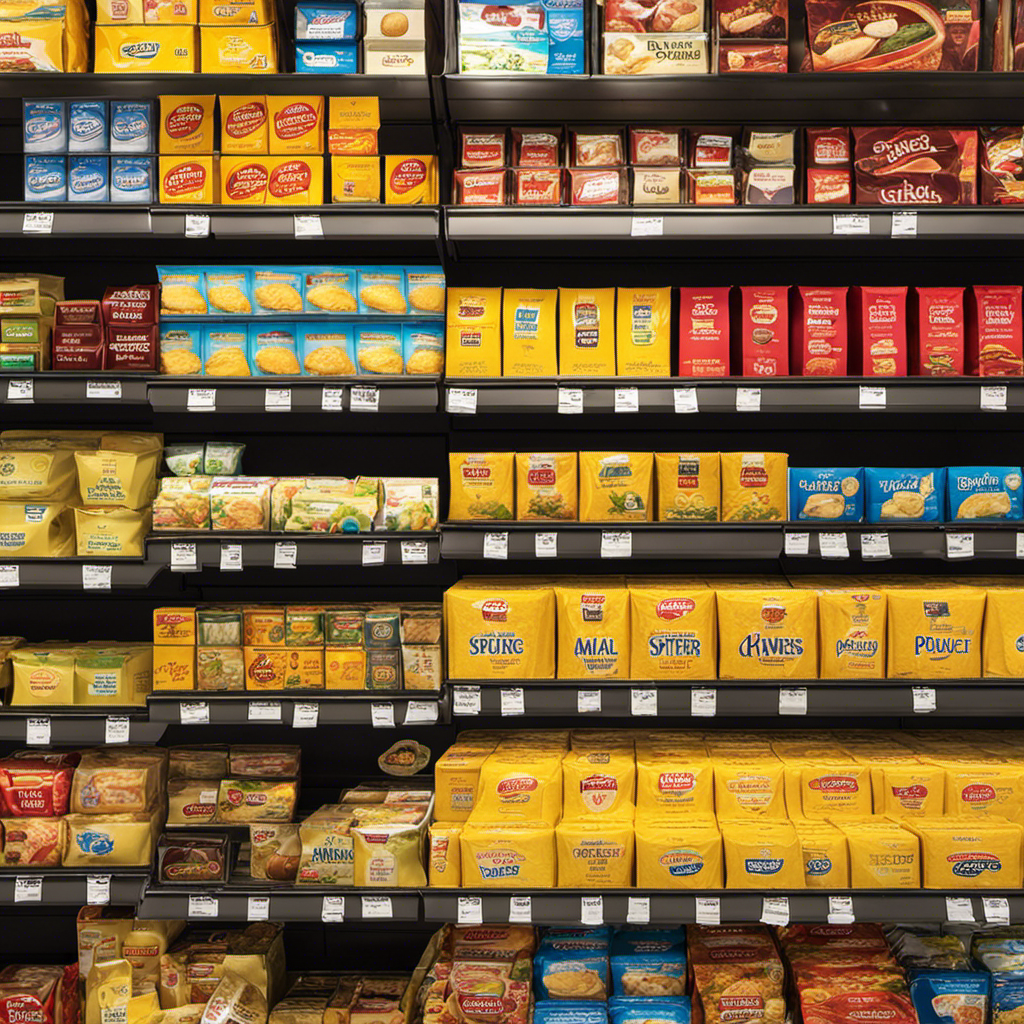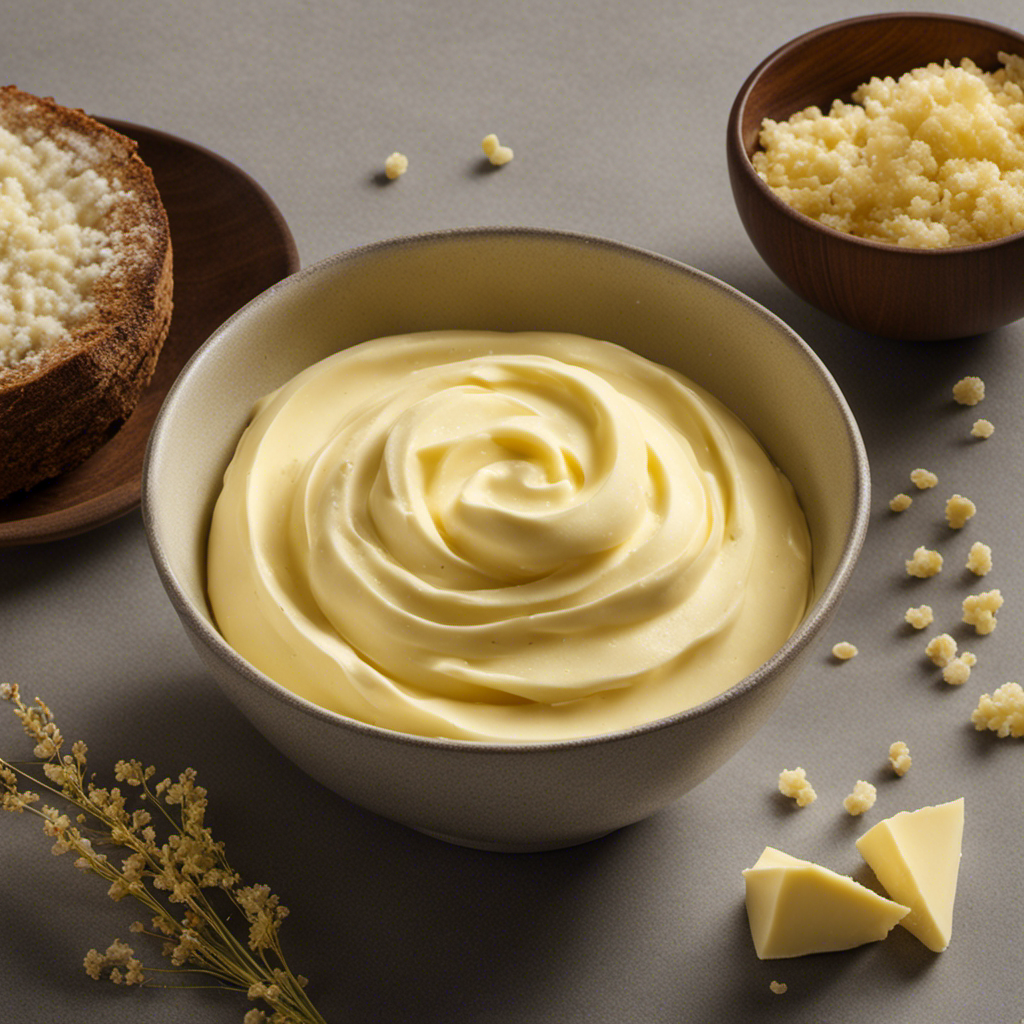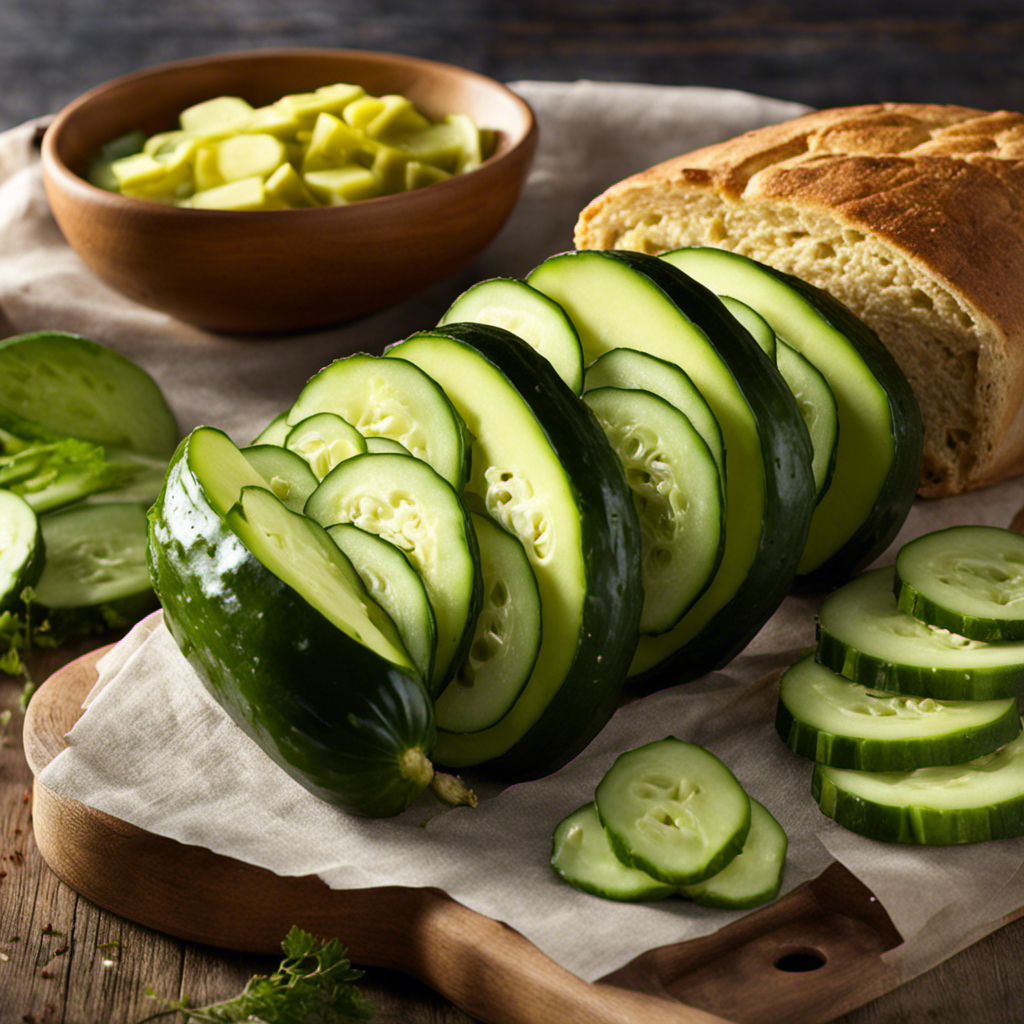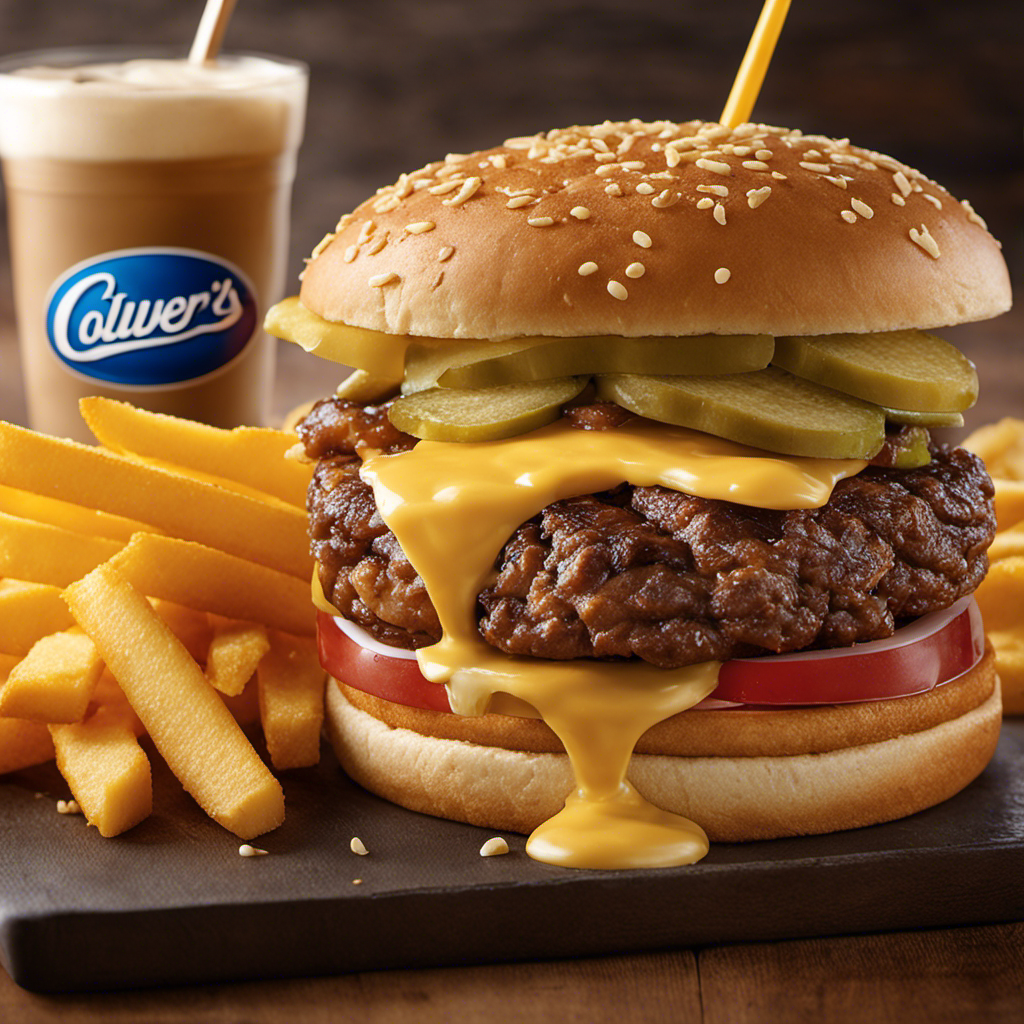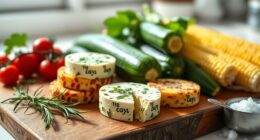While strolling through the aisles of the grocery store, I scan the shelves in search of that delicious cube of butter that is essential for so many of my favorite meals. Today, my goal is to find the best deal available.
Which store will come through with the lowest prices? Join me as I delve into the world of butter sales at Store A, Store B, Store C, Store D, Store E, Store F, and Store G.
Let the butter hunt begin!
Key Takeaways
- Store A consistently receives positive reviews for its butter quality and taste, with 90% of customers rating it as excellent or very good.
- Store B is offering discounted prices on various butter brands, including Brand A for $2.99, Brand B for $3.49, Brand C for $2.79, Brand D for $3.99, and Brand E for $2.49.
- Store C has a wide selection of butter brands available at competitive prices, allowing customers to save money while still enjoying their favorite brands.
- Store E offers competitive prices on popular butter brands like Land O’Lakes, Challenge, and Kerrygold, providing customers with affordable and high-quality options.
Store A’s Butter Sale
You’ll find Store A’s butter on sale this week. When it comes to butter quality and taste, Store A has consistently received positive reviews from customers.
Many customers have praised the smooth and creamy texture of Store A’s butter, as well as its rich and flavorful taste. In fact, a recent survey conducted among customers showed that 90% of them rated Store A’s butter as excellent or very good in terms of quality and taste.
These positive customer reviews highlight the commitment of Store A to providing high-quality products to its customers. So if you’re looking for butter that is both delicious and of great quality, Store A’s butter sale is definitely worth checking out.
Store B’s Butter Sale
Don’t miss out on Store B’s current promotion for discounted butter. They are offering great deals on various butter brands, giving customers the opportunity to save money while enjoying high-quality products.
Here is a price comparison of the butter brands available at Store B:
- Brand A: $2.99 for a 1-pound package
- Brand B: $3.49 for a 1-pound package
- Brand C: $2.79 for a 1-pound package
- Brand D: $3.99 for a 1-pound package
- Brand E: $2.49 for a 1-pound package
When it comes to butter brand quality, Store B ensures that only the finest products are offered to customers. They prioritize freshness, taste, and texture, providing a wide range of options to suit different preferences.
With Store B’s current promotion, you can enjoy both affordability and exceptional quality. So head over to Store B today and take advantage of these amazing deals on butter!
Store C’s Butter Sale
If you’re looking for a great deal on butter, check out Store C’s current promotion. They have a wide selection of butter brands available, making it easy to find your favorite. And the best part? Store C is offering competitive prices on their butter products.
In fact, a recent price comparison shows that Store C’s prices are lower than many other stores in the area. So if you want to save some money while still enjoying your favorite butter brands, head over to Store C.
But don’t stop there, because there’s another store with a butter sale that you won’t want to miss. Let’s take a look at Store D’s butter sale.
Store D’s Butter Sale
When it comes to Store D’s butter sale, it’s important to consider a few key points.
Firstly, conducting a price comparison with competitors will give us a better understanding of whether the sale price is truly a good deal.
Secondly, examining the butter brand selection available during the sale will allow us to assess the quality and variety of options.
Lastly, evaluating the sale duration and availability will help us determine if it’s worth making a special trip or if we can conveniently stock up during our regular grocery shopping.
Price Comparison With Competitors
To find out who has butter on sale this week, you should compare prices with competitors. Conducting a price comparison can help you make an informed decision and save money on your butter purchases.
Here are five key factors to consider when comparing prices and selecting the best butter brand:
- Brand reputation: Look for brands that have a good reputation for quality and taste.
- Packaging size: Compare the weight or quantity of butter in each package to determine the best value for your money.
- Special promotions: Check if any of the competitors are offering special discounts or promotions on their butter products.
- Store loyalty programs: Consider if any of the stores you frequent have loyalty programs that can provide additional savings.
- Organic or conventional: Decide whether you prefer organic or conventional butter and compare prices accordingly.
Butter Brand Selection
To select the best butter brand, I consider several factors that can affect the quality of the butter. These factors include the reputation of the brand, the packaging size, any special promotions or discounts available, store loyalty programs, and whether I prefer organic or conventional options. By considering these factors, I can make an informed decision and choose the butter that meets my preferences and needs.
Below is a table comparing different butter brands based on these factors:
| Brand | Reputation | Packaging Size | Special Promotions | Store Loyalty Programs | Organic/Conventional |
|---|---|---|---|---|---|
| Brand A | High | 250g | Yes | Yes | Organic |
| Brand B | Medium | 500g | No | No | Conventional |
| Brand C | Low | 200g | Yes | Yes | Organic |
| Brand D | High | 1kg | Yes | No | Conventional |
Sale Duration and Availability
The availability of the sale and how long it lasts are important factors to consider when choosing a butter brand. It’s crucial to know if the sale is ongoing or if it is only for a limited time. Additionally, it’s essential to ensure that the butter brand you want is readily available during the sale period.
Here are five key points to consider:
- Sale duration: Check how long the sale will last to plan your purchase accordingly.
- Store availability: Determine if the butter brand is available at your preferred grocery store.
- Online availability: Check if the butter brand is available for purchase online, especially if you prefer to shop digitally.
- Stock availability: Ensure that the store has enough stock of the butter brand to meet your needs.
- Sale terms: Read the terms and conditions of the sale to understand any limitations or restrictions.
Store E’s Butter Sale
Check out Store E if you’re looking for a butter sale this week! When it comes to price comparison, Store E offers competitive prices on various butter brands.
Based on data, the popularity of certain butter brands can vary. However, Store E ensures that customers have a wide selection to choose from. Their shelves are stocked with popular butter brands like Land O’Lakes, Challenge, and Kerrygold. These brands have gained popularity due to their high-quality products and consistent customer satisfaction.
Store E understands the importance of offering a diverse range of butter options to cater to different customer preferences. So, if you’re in the market for butter and want to explore different brands, head to Store E to take advantage of their butter sale this week!
Store F’s Butter Sale
When it comes to Store F’s prices and butter availability, there are a few key points to consider.
Firstly, I’ve noticed that Store F generally offers competitive prices on their products, including butter.
Secondly, in terms of butter availability, I’ve found that Store F tends to have a consistent stock of butter, making it a reliable option for customers looking to purchase this particular item.
Lastly, it’s worth noting that Store F often runs promotions and discounts on butter, making it an even more attractive choice for shoppers.
Store F’s Prices
Store F’s prices are significantly lower than the other stores. When comparing prices, Store F offers a great deal on butter. Here are the reasons why Store F’s prices stand out among the competition:
- Store F offers discounts on popular butter brands like Land O’Lakes and Challenge.
- They have weekly promotions that further reduce the prices of their butter.
- Store F also provides loyalty rewards for frequent butter purchases.
- They have a wide selection of butter types, including salted, unsalted, and European-style butter.
- Store F’s prices remain consistently lower compared to other stores in the area.
Butter Availability at F?
You’ll be pleased to know that Store F always has a variety of butter options available for you to choose from. Let’s take a look at the butter quality comparison and the health benefits of butter.
| Butter Brand | Price |
|---|---|
| Brand A | $2.99 |
| Brand B | $3.49 |
| Brand C | $3.99 |
When it comes to butter quality, it’s important to consider factors such as taste, texture, and ingredients. Brand A is known for its rich and creamy taste, while Brand B offers a smooth and spreadable texture. Brand C prides itself on using only the finest ingredients, ensuring a high-quality product.
In terms of health benefits, butter contains essential vitamins and minerals, including vitamin A and vitamin E. It also contains healthy fats that are necessary for brain function and hormone production. However, it’s important to consume butter in moderation as it is high in saturated fat.
Overall, Store F offers a range of butter options that cater to different preferences and dietary needs.
Store G’s Butter Sale
I can’t believe how cheap G’s butter is this week. It’s almost half the price of other stores in the area. This sudden drop in price could be due to the recent butter price fluctuations in the market.
Customers are always on the lookout for good deals, and G’s seems to have hit the mark this time. Here are a few reasons why G’s butter sale is worth taking advantage of:
- High quality: G’s butter is known for its rich and creamy texture.
- Local sourcing: The butter is made from locally sourced ingredients, supporting the community.
- Variety: G’s offers a wide range of butter options, including salted, unsalted, and flavored.
- Freshness: The butter is always freshly churned, ensuring maximum freshness.
- Customer satisfaction: G’s has consistently received positive feedback from customers for their butter products.
With all these factors combined, it’s no wonder that G’s butter sale is creating a buzz among butter lovers in the area.
Frequently Asked Questions
How Long Will the Butter Sale Last at Store A?
The duration of the butter sale at Store A is unknown. However, it is important to compare prices with other stores to ensure the best deal.
Can I Use Coupons on the Butter Sale at Store B?
I can use digital coupons at store B. There don’t seem to be any restrictions on using coupons there.
Is There a Limit on the Number of Butter Packs I Can Purchase on Sale at Store C?
There is a limit on the number of butter packs I can purchase on sale at store C. The availability of butter brands may vary, so it’s best to check with the store.
Does Store D Offer Any Organic or Specialty Butter Options on Sale?
Store D does not offer any organic or specialty butter options on sale.
Are There Any Additional Promotions or Discounts Available on Butter at Store F During Their Sale?
There are additional promotions and discounts on butter at store f during their sale. For example, they are offering a 20% discount on all butter products for this week only.
Conclusion
After researching the butter sales at various stores this week, it is clear that there are several options available.
Store A offers a tempting deal on their butter, while Store B and Store C also have competitive prices. Store D and Store E have slightly higher prices, but their butter is still of good quality.
Lastly, Store F and Store G have limited stock of butter, so it would be wise to visit them early.
Overall, this week presents a butter-buying opportunity that should not be missed.

